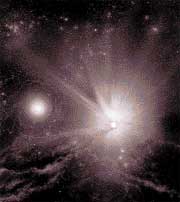Stars apart
 stars , apart from emitting visible light, also emit radiation in the other regions of the electromagnetic spectrum. There are stars which primarily give out visible light, like our Sun, or those which give out most of their energy in the form of radio waves or x -rays. The Sun is a poor x -ray emitter, giving out only about a millionth of its output in the form of x -rays. But with some recent observations, there are indications that in the early years of its evolution, the Sun may have been a far more powerful x -ray source than today.
stars , apart from emitting visible light, also emit radiation in the other regions of the electromagnetic spectrum. There are stars which primarily give out visible light, like our Sun, or those which give out most of their energy in the form of radio waves or x -rays. The Sun is a poor x -ray emitter, giving out only about a millionth of its output in the form of x -rays. But with some recent observations, there are indications that in the early years of its evolution, the Sun may have been a far more powerful x -ray source than today.
This finding could have a profound impact on our understanding of the formation and evolution of the inner solar system.M Grosso and a group of scientists from France, usa and Brazil have reported an x -ray outburst of enormous intensity from a young infrared protostar, ylw 15, located about 500 light years away from the Earth. A protostar is a contracting mass of gas representing a star in an early stage of formation ( Nature , Vol 387, No 6628).
The Class i protostar is a very young (about 100,000 years old) low-mass object that is surrounded by an accretion disc and is embedded in a envelope of dust and gas. This is what makes it invisible to optical telescopes. But it can be detec-ted by its infrared signature generated when the dust or gas falls into the star.
But x -rays, which have much higher energy, have also been detected in a brief burst or flare, using instruments on board of the orbiting observatory rosat . The results obtained are significant because a clear-cut identification of the source of the x -ray burst in the protostar has been achieved for the first time. More importantly, the amount of energy given out by the object in the x -ray region is enormous and is much more than any other source in our galaxy (with the exception of objects like neutron stars and white dwarfs). The ylw 15 is about ten million times brighter (in the x -ray region) than the Sun.
These results throw up many questions regarding the evolution of the Sun. It is believed that the Sun gives out x -rays by a process of magnetic reconnection where the hot plasma in the corona, trapped in closed magnetic structures, gives out the radiation. If the same process is responsible for the energy release in the protostar, then there is a question mark on the location of the source of the magnetic field.
If the same process is not operative in the protostar, then in the early phases of its evolution, the Sun would also have released huge amounts of x -rays which could have had significant effects on the formation of the solar system. The resolution of all these questions might lead to a radical change in our theories of the formation and evolution of the solar system.
